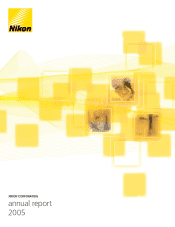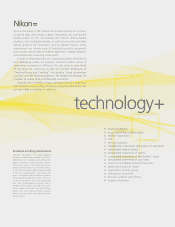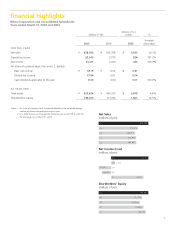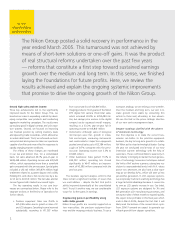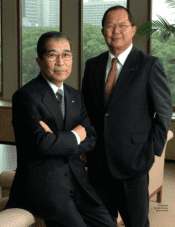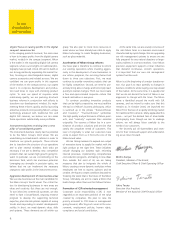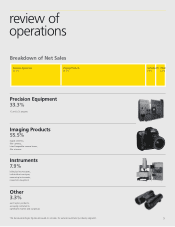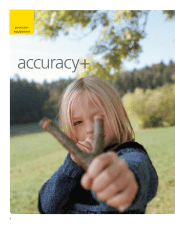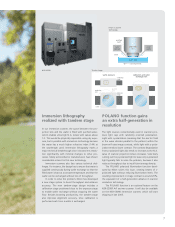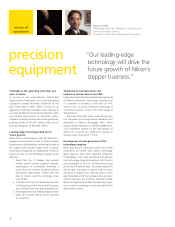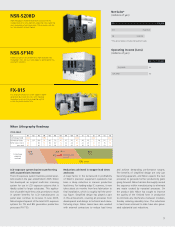Nikon 2005 Annual Report Download - page 10
Download and view the complete annual report
Please find page 10 of the 2005 Nikon annual report below. You can navigate through the pages in the report by either clicking on the pages listed below, or by using the keyword search tool below to find specific information within the annual report.
precision
equipment
Profi table at the operating level after two
years of losses
A recovery in the semiconductor market and
higher levels of investment in LCD manufacturing
equipment created favorable conditions in the
year ended March 2005. Nikon focused on an
aggressive marketing campaign while seeking to
cut costs and shorten production lead times. Sales
rose 35.6% year-on-year to ¥214,326 million.
Segment operating income improved signifi cantly,
posting a profi t of ¥11,387 million, after a prior-
year operating loss of ¥20,806 million.
Leading-edge technology holds key to
future growth
Nikon offers a full lineup of i-line, KrF and ArF IC
steppers and scanners to cater to diverse market
requirements. Maintaining a technological lead as
the market shifts toward higher levels of device
shrinking is recognized as fundamental to Nikon’s
future success, as the following strategic points
illustrate.
1. Given that the IC stepper and scanner
market cannot sustain explosive growth,
maintenance of profi tability demands a
closer focus on machine unit prices and on
developing high-margin models that can
help IC makers push the shrinkage enve-
lope further.
2. Customers for the most advanced scanners
will frequently order i-line and KrF steppers
and scanners from the same manufacturer.
3. The establishment of leading-edge technol-
ogies can provide diverse future solutions
to customers.
Shipments of next-generation ArF
immersion scanner due in late 2005
Laboratory tests have demonstrated the superiority
of Nikon’s immersion technology, showing that
it is possible to produce a lens with an N.A.
value of over 1.0 using immersion technology. A
commercial scanner is now in the fi nal stages of
development.
Extensive tests have been conducted by sev-
eral customers on an engineering evaluation tool
developed at Nikon’s Kumagaya Plant. Nikon
plans to begin shipments of the NSR-S609B (N.A.
1.07) immersion scanner in the fi nal quarter of
2005 (CY). It will be the world’s fi rst scanner to
achieve a lens in excess of 1.0 N.A..
Development of next-generation EUVL
technology ongoing
Nikon sees the ArF immersion scanner as the fi nal
incarnation of excimer laser based technology.
Nikon believes that EUVL (Extreme Ultraviolet
Lithography) is the most promising next-genera-
tion technology beyond immersion. EUVL works
at a wavelength of 13.5 nm, 14 times shorter than
that of an ArF excimer laser. This means that EUVL
will be able to provide IC makers with the extra
resolution to support the required device shrink-
age. Development of the necessary ultra-precision
mirrors has been the foremost technical hurdle.
Nikon has applied its wealth of proprietary exper-
tise in optical technology to this and other EUVL
development issues.
review of
operations
Kazuo Ushida
Managing Director, Member of the Board &
Senior Executive Offi cer
President of Precision Equipment Company
“Our leading-edge
technology will drive the
future growth of Nikon’s
stepper business.”
8

